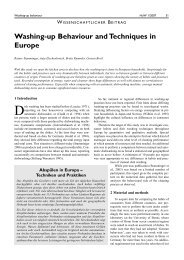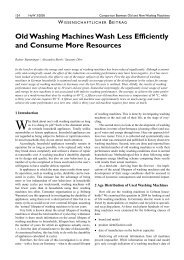Development of a novel mechatronic system for mechanical weed ...
Development of a novel mechatronic system for mechanical weed ...
Development of a novel mechatronic system for mechanical weed ...
Create successful ePaper yourself
Turn your PDF publications into a flip-book with our unique Google optimized e-Paper software.
Materials and methods<br />
prototyping is even more evident in the testing and analysis phase. With a<br />
virtual prototype, upon completion <strong>of</strong> the simulation, all the calculated data can<br />
be accessed and processed immediately. The raw data can be directly<br />
analysed inside the s<strong>of</strong>tware or easily imported into another numerical<br />
application <strong>for</strong> further analysis. The scope <strong>of</strong> the data includes almost<br />
everything that exists under real operating conditions: <strong>for</strong>ces, deflections,<br />
displacements, stresses, etc.<br />
Another advantage <strong>of</strong> virtual prototyping is the flexibility it <strong>of</strong>fers in prototype<br />
design. In traditional prototyping, many different ideas are brainstormed,<br />
eventually resulting in several scaled mock-ups. The number <strong>of</strong> prototypes<br />
produced is usually limited because <strong>of</strong> cost, material availability, and<br />
manufacturing and storage space limitations. Once a prototype is produced, any<br />
changes in the design need to be implemented manually. Unless a major<br />
overhaul <strong>of</strong> the prototype is acceptable, only small changes are possible,<br />
because large design changes are impractical. With virtual prototyping there is<br />
no limitation caused by costs or space requirements to build the prototype, so<br />
any number <strong>of</strong> design variations are possible. A part change or modification is<br />
automatically updated, maintaining the project without necessity <strong>for</strong> corrections<br />
in all versions <strong>of</strong> the prototype. Additionally, a current version can be easily<br />
reverted back to an earlier design stage, because all the changes made during<br />
the design process have been stored as a back-up.<br />
Most <strong>of</strong> the outcomes <strong>of</strong> physical prototyping can be achieved in virtual<br />
prototyping. All the dimensional interactions between parts can be examined.<br />
By being able to look at the virtual model from any angle, any issue involving<br />
line-<strong>of</strong>-sight or part interferences can be checked and different kinds <strong>of</strong><br />
kinematical interactions can be tested.<br />
It should be noted that virtual prototyping does not by definition include a<br />
comprehensive virtual reality environment, but any virtual prototype can<br />
certainly be extended and experienced in virtual reality if the proper equipment<br />
is available (Wang 2002). A virtual environment (VE) allows a user to<br />
completely interact within the same environment as the product, <strong>of</strong>ten with the<br />
use <strong>of</strong> large-scale flat-wall displays, goggles, or CAVE immersive room<br />
44





